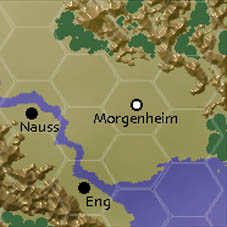
| Morgenhelm |
| About 2,000 years ago a new force made itself felt in Arda. The high priests of a dozen religions held council at the Human city of Morgenhelm. It was decided that the religions of Arda would organize themselves into a central church, building common cathedrals that each contained shrines to the member gods, thus binding all the major religious traditions into a single system of belief. This was called the Covenant, and the twelve major gods and their lesser dieties were indexed and granted Covenant Charters as Holy Orders of the Church. Any cults and temples devoted to any dieties not included in the Covenant were deemed Heretics and denied the benefits of the Holy Church.
For a thousand years, the Covenant acted as a force for good in Arda. The Covenant gave many races a way to discuss their differences in a peaceful way, and reflect on the things that bind them together in harmony. The elected position of Arch-Heirophant was circulated amoung the various religions and races, and matters of justice were heard at the Covenant churches. The Tellurian was abandoned, replaced by the Holy Scripture that detailed a code of living for all the people of Arda. At last there was now a force that could oppose the brutality of the shadowy Draconian Legion whose influence could be felt in every town and city, yet had no nation, no armies. The Dragon Lords brought barbarian hordes in from foreign parts and used them to raid churches, desecrating their shrines. The Covenant fought back, organizing an armed force of Clerics and Paladins and sending them out to battle against the Heretic Hordes and defend the Holy Church from evil. Before long, Morgenhelm became more like a fortress and less like a learned holy city. Soldiers and machinery of war would be seen more often than monks in quiet contemplation. The Arch-Heirophant Nicomedes Sulla declared himself to be King of Morgenhelm in 8522 YC, about 1500 years ago, and took direct command of the Holy Church and all its lands. The Heretic Hordes were soon defeated, send scattered into the wilds and across the Northern Sea, but many within the Covenant were not happy with the turn of events. Nicomedes soon found that his throne was not secure. To secure his power, he assembled a core of fiercely zealous clerics and formed the witch-hunting seret army known as the Holy Inquisition. Their stated purpose was to root out heretics and secure the lands of the Church against evil, but all too often they abused their power, causing fear and silencing Nicomedes' political opponents. The miscontented grimblings in the Covenant soon grew to a fever pitch until finally it boiled over into open war. The heads of various religions broke away from the Covenant, starting new temples and declaring the shrines within the Holy Church to be heretical. Confusion spread like a cancer as Church groups and independent religious leaders fought for the belief of the faithful. Purges and pogroms were carried out even within certain religious traditions as clerics, paladins and monks all turned on each other in a vicious gang war of assassinations, lynchings and terror attacks. This was called the Schism War, and it all but drove the people of Arda away from religion altogether. The Covenant of Morgenhelm persists to this day, some still obediently attending services in the crumbling churches that still stand in the major towns and cities. The Holy Fortress still stands tall, its ancient banners hanging on its walls, their faded colors a mockery of the glory days of old. In the lands of the Holy Kingdom that immediately surround Morgenhelm, the Church is still infallable and the preisthood are served as great lords. But in the lands beyond the borders, it is another matter. Morgenhelm is seen as a corrupt and crumbing empire. The Holy Crusaders are all but gone, monastries burnt to the ground. Religion is mostly ruined. Many people feel that the gods have abandoned Arden, but out of the ashes, new growth has started to emerge. Small shrines, built by people of faith have started to appear, and lay preists have assembled congregations and started to reintroduce prayer and worship into the lives of simple townsfolk. The calendar of Arden is still the Covenant calendar, and the current year is 12,674 YC. |
| return to main |